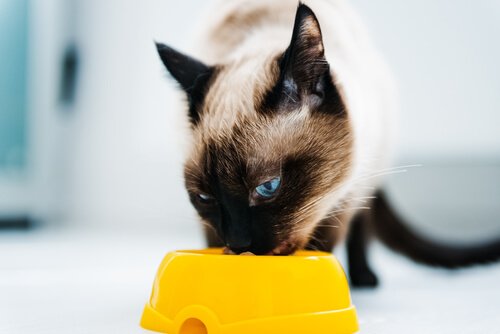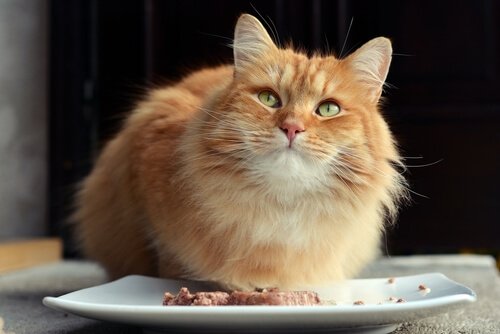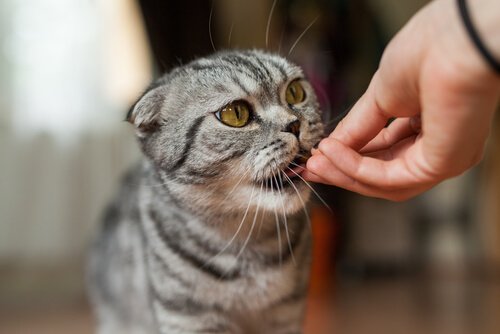What Food Can You Give to a Cat if Their Food is All Gone?

Unlike dogs, cats don’t usually “eat anything” beyond their cat food, tuna, or pâté. If your cat’s food runs out and you don’t have time to go to the grocery store, you can improvise with some food at home. In this article you can find out what foods and ingredients at home are good for them.
My cat is hungry… and I don’t have cat food

It’s difficult to understand… but it seems that cats have an internal clock that tells them when it’s time to eat. If fact, they will even let you know up front (so there aren’t any misunderstandings or communication problems).
Meowing next to an empty plate, constant rubbing against our legs, staring with droopy eyes just like “Puss in Boots“, putting themselves face to face with us… they won’t stop until you get up and fill their food dish.
However, sometimes there is no time to buy groceries, and there isn’t any cat food. What do you do when the cat food bag is empty and your cat is putting on his begging face? Fortunately, this recurring nightmare can come to an end for all cat owners.
Other than paying attention to them and buying food before it runs out (or getting into the habit of buying more food even if the bag is still halfway full), you can resort to some cat friendly human foods.
The human food will cause them no harm as long as these foods are given to them even once in a while and in small amounts. The human diet can be nutritious and good for pets because it contains vitamins, minerals, and carbohydrates that are essential for their growth and development. Without it becoming a habit, you can have dinner with your cat without any problem.
What to know about feeding cats
It’s important to know the most important aspects related to your cat’s nutrition. These are the characteristics that every owner should know:
1. Cats eat meat
This is because they are carnivores. So, they can eat chicken, beef, pork, and fish. It is recommended that the meat is cooked to prevent any diseases.
2. Cats consume dry and wet food
Some owners prefer to give them those little packets of wet food and others leave them dry food in their dish. Both meet the cats’ nutritional needs at any age. The best would be mixing both types of food, especially so they don’t get used to only one type and don’t reject the other when you run out of his normal food.
3. Cats eat when they want to
You can’t force your cat to eat when you think it’s time to have lunch or dinner. Felines are so independent that they decide the right time to feed themselves. The good news is that they manage their food and only eat whenever they need to. If you leave the house in the morning and come back in the afternoon, don’t forget to fill the dish before leaving.
4. Cats also drink water
Just like any other mammal, cats need to hydrate themselves through food and water. If you give them only dry food, then you will have to satisfy their need for water in another bowl (which should always be clean and full). If they eat wet food, perhaps they won’t drink the water, but you should offer it to them anyways.
5. Cats eat according to their age

The nutritional needs of felines vary depending on their age. From 5 to 40 weeks old, they need between 30 and 80 grams of food per day. From 1 to 6 years old, they should eat around 40 to 130 grams per day, and when they older than 7 years old, from 30 to 135 grams per day.
What could I give my cat to eat if his food has run out?
You can try these options:
- Meat: chicken, beef, or turkey.
- Fish: especially tuna (which they love) or any other fish as long as it’s cooked.
- Vegetables: carrots, chard, beets, tomatoes, and zucchini.
- Fruit: apples, pears, and peaches.
All cited sources were thoroughly reviewed by our team to ensure their quality, reliability, currency, and validity. The bibliography of this article was considered reliable and of academic or scientific accuracy.
- Jurado, A. (2020) Evaluación de una dieta casera complementaria utilizada en la alimentación de gatos (Felis catus silvestre) del refugio de animales Amigos con Cola y su efecto sobre el estado de salud animal. (Tesis de grado, Universidad Católica de Santiago de Guayaquil)
- Davies, R. H., Lawes, J. R., & Wales, A. D. (2019). Raw diets for dogs and cats: a review, with particular reference to microbiological hazards. Journal of Small Animal Practice, 60(6), 329-339.